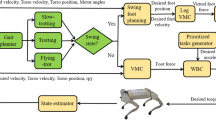Abstract
Developing efficient walking gaits for quadruped robots has intrigued investigators for years. Trot gait, as a fast locomotion gait, has been widely used in robot control. This paper follows the idea of the six determinants of gait and designs a trot gait for a parallel-leg quadruped robot, Baby Elephant. The walking period and step length are set as constants to maintain a relatively fast speed while changing different foot trajectories to test walking quality. Experiments show that kicking leg back improves body stability. Then, a steady and smooth trot gait is designed. Furthermore, inspired by Central Pattern Generators (CPG), a series CPG model is proposed to achieve robust and dynamic trot gait. It is generally believed that CPG is capable of producing rhythmic movements, such as swimming, walking, and flying, even when isolated from brain and sensory inputs. The proposed CPG model, inspired by the series concept, can automatically learn the previous well-designed trot gait and reproduce it, and has the ability to change its walking frequency online as well. Experiments are done in real world to verify this method.
Similar content being viewed by others
References
Dickinson M, Farley C, Full R, Koehl M A R, Kram R, Lehman S. How animals move: an integrative view. Science, 2000, 5463, 100–106.
Wu Q, Liu C, Zhang J, Chen Q. Survey of locomotion control of legged robots inspired bybiological concept. Science in China (Series F), 2009, 10, 1715–1729.
Ayers J, Witting J. Biomimetic approaches to the control of underwater walking machines. Philosophical Transactions: Mathematical, Physical and Engineering Sciences (Series A), 2007, 1850, 273–295.
Pinto C, Rocha D, Santos C, Matos V. A new CPG model for the generation of modular trajectories for hexapod robots. The Proceedings of International Conference on Numerical Analysis and Applied Mathematics, Halkidiki, Greece, 2011, 504–508.
Ijspeert A J, Crespi A, Ryczko D, Cabelguen J. From swimming to walking with a salamander robot driven by a spinal cord model. Science, 2007, 5817, 1416–1420.
Kimura H, Fukuoka Y, Cohen A H. Adaptive dynamic walking of a quadruped robot on natural ground based on biological concepts. International Journal of Robotics Research, 2007, 5, 475–490.
Saif S. Central pattern generator parameter search for a biped walking robot. European Journal of Scientific Research, 2011, 3, 466–477.
Wang X, Li M, Wang P, Guo W, Sun L. Bio-inspired controller for a robot cheetah with a neural mechanism controlling leg muscles. Journal of Bionic Engineering, 2012, 9, 282–293.
Raibert M H, Chepponis M A, Brown H B. Experiments in balance with a 3D one-legged hopping machine. International Journal of Robotics Research, 1984, 3, 75–92.
Raibert M H, Chepponis M A, Brown H B. Running on four legs as though they were one. International Journal of Robotics and Automation, 1986, 2, 70–82.
Kuo A D. The six determinants of gait and the inverted pendulum analogy: a dynamic walking perspective. Human Movement Science, 2007, 26, 617–656.
Kohl N, Stone P. Policy gradient reinforcement learning for fast quadruped locomotion. The Proceedings of IEEE International Conference on Robotics and Automation, New Orleans, LA, USA, 2004, 2619–2624.
Soni V, Singh S. Reinforcement learning of hierarchical skills on the Sony AIBO robot. The Proceedings of the 5th International Conference on Development and Learning, Bloomington, IN, USA, 2006, 1231–1237.
Zhang J, Chen Q. Learning based gaits evolution for an AIBO dog. The Proceedings of IEEE Congress on Evolutionary Computation, Singapore, 2007, 1523–1526.
McGeer T. Passive dynamic walking. International Journal of Robotics Research, 1990, 9, 62–82.
Kuo A D. Energetics of actively powered locomotion using the simplest walking model. Journal of Biomechanical Engineering, 2002, 124, 113–120.
Wisse M. Three additions to passive dynamic walking: Actuation, an upper body, and 3d stability. International Journal of Humanoid Robotics, 2005, 2, 459–478.
Collins S, Ruina A, Tedrake R, Wisse M. Efficient bipedal robots based on passive-dynamic walkers. Science, 2005, 307, 1082–1085.
Matsuoka K. Mechanisms of frequency and pattern control in the neural rhythm generators. Biological Cybernetics, 1987, 56, 345–353.
Acebron J A, Bonilla L L, Vicente C J P. The Kuramoto model: A simple paradigm for synchronization phenomena. Reviews of Modern Physics, 2005, 77, 137–185.
Liu C, Chen Q, Zhang J. Coupled Van der Pol oscillators utilised as central pattern generators for quadruped locomotion. The Proceedings of Chinese Control and Decision Conference, Guilin, China, 2009, 3677–3682.
Spröwitz A, Tuleu A, Vespignani M, Ajallooeian M, Badri E, Ijspeert A J. Towards dynamic trot gait locomotion: design, control, and experiments with Cheetah-cub, a compliant quadruped robot. International Journal of Robotics Research, 2013, 8, 932–950.
Semini C, Tsagarakis N G, Guglielmino E, Focchi M, Cannella F, Caldwell D G. Design of HyQ — a hydraulically and electrically actuated quadruped robot. The Proceedings of the Institution of Mechanical Engineers, Part I: Journal of Systems and Control Engineering, 2011, 6, 831–849.
Tian W, Cong Q, Menon C. Investigation on walking and pacing stability of German shepherd dog for different locomotion speeds. Journal of Bionic Engineering, 2011, 8, 18–24.
Tang C, Ma S, Li B, Wang Y. A self-tuning multi-phase CPG enabling the snake robot to adapt to environments. The Proceedings of the IEEE/RSJ International Conference on Intelligent Robots and Systems, San Francisco, CA, USA, 2011, 1869–1874.
Righetti L, Buchli J, Ijspeert A J. Dynamic hebbian learning in adaptive frequency oscillators. Physica D, 2006, 2, 269–281.
Zhang J, Zhao X, Qi C. A series inspired CPG model for robot walking control. The Proceedings of the 11th International Conference on Machine Learning and Applications, Boca Raton, FL, USA, 2012, 444–447.
Author information
Authors and Affiliations
Corresponding author
Rights and permissions
About this article
Cite this article
Zhang, J., Gao, F., Han, X. et al. Trot Gait Design and CPG Method for a Quadruped Robot. J Bionic Eng 11, 18–25 (2014). https://doi.org/10.1016/S1672-6529(14)60016-0
Published:
Issue Date:
DOI: https://doi.org/10.1016/S1672-6529(14)60016-0




